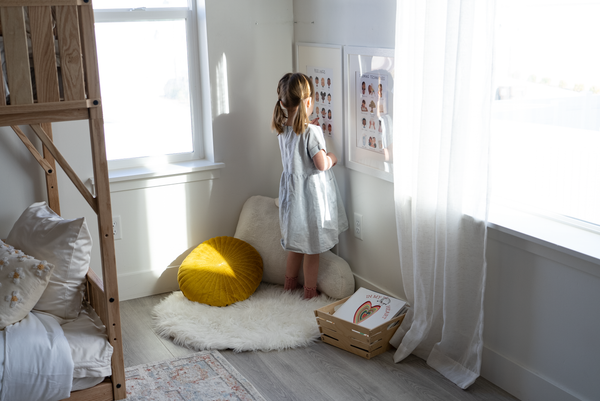How to Create a Calm Corner in your Home
We've all been there... one moment your toddler is happily playing with their favorite toy or painting a picture of a butterfly, and the next they are in the middle of an epic meltdown that makes you question yourself as a parent. While this can be an incredibly frustrating experience for adults, it's important to remember that meltdowns are common and very normal for toddlers. Children are complex and their attempts at emotional regulation don't make you a bad parent or mean you are doing anything wrong. Children are constantly learning and when they are having difficulty navigating their emotions, it can quickly lead to a meltdown or tantrum. A calm corner can be an important tool in helping your little one learn how to regulate these big emotions early on.
What is a Calm Corner?
A calm corner is a designated area that is intentionally prepared as a safe space where children can go to take a break and reset when they are experiencing strong emotions. Providing a child with this space can allow them to practice healthy coping strategies and empower them to manage their stress in helpful ways. It's important to remember that Calm Corners are not time-outs and should not be used as a punishment. They are meant to be safe and comforting; a way for a child to take deep breaths and let their emotions settle before they become too big for the child to handle. We recommend that a child should never be forced to spend time in the calm corner.

What to Include in Your Calm Corner
Once you determine a quiet space that is free from distractions that you feel comfortable designating as your calm corner, you will then need to choose what items to include. Every child is different, so it's important to consider your specific child's personality when making this decision.
-
Comfy Items - It can be difficult to be calm when you are uncomfortable. Comfort items can help children feel safe and secure. These can include stuffed animals, blankets, pillows, or soft toys.
-
Fidget or Sensory Toy - Sensory items can also provide a distraction from overwhelming emotion and help children focus their attention.
-
Visual Prompts - Visual reminders of what emotions are and how to regulate them can be helpful for a child while using the corner to regulate their emotions.
-
Coloring Tools - Coloring can be a soothing and meditative activity for some children
-
A Sand Timer - A sand timer not only measures the amount of time that your child typically spends in the corner but can also have a soothing effect when your child watches the sand filter downward.
-
I Spy Bottles - An I Spy Bottle can help a child with self-regulation when feeling anxious or overstimulated and is easy to make yourself.
A Note About Organizing Your Calm Corner:
If you are interested in containing the items in your calm corner, a small basket can be helpful, as well as a small table or floor desk. You can rotate out items as needed to keep things interesting and appealing.
How to Introduce Your Child to a Calm Corner
To start, it can be helpful to visit the calm corner together. Identify how both you and your child are feeling using a Feelings Chart if you have one. Sit quietly with your child and model the use of the activities that you provided within the Calm Corner. Talk to your child about what is expected of them while they are in the calm corner while they are relaxed and content to ensure they fully understand the boundaries. It can help to reinforce the idea that taking a break from what they were doing is ok, and as soon as they are feeling better they can return to what they were previously doing.
A Few Things to Remember When Using a Calm Corner:
-
A calm corner should be used for stopping a meltdown before it occurs, not once the child is already in meltdown mode.
-
Be consistent with providing positive feedback for children who use the calm corner to emotionally regulate.
-
If your child is having difficulty adapting to the idea of the calm corner, it can be helpful to stay with your child in the calm corner while they are overwhelmed or stressed.
Emotional regulation is a tough skill to master! You may not see immediate results from your little one, but the more that they practice the easier it will become.

Emotional regulation posters can be a helpful tool to help a child navigate big feelings. Enter your email below to be sent a free download straight to your inbox!





Where can I find the emotions and calming techniques posters?
Lindsay on
Hello! Do you have a link for the poster prints in the article’s photo? Thanks so much.
Keira on